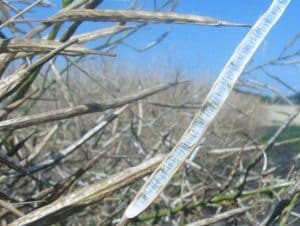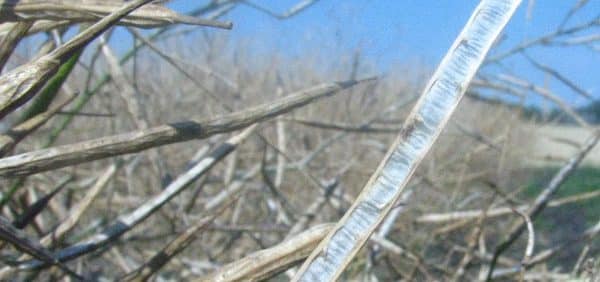Most canola growers are familiar with straight combining, even if most have not tried it yet. New varieties with pod shatter resistance have helped with the overall comfort level for the practice.
This article looks at situations where swathing may still have an advantage over straight combining.

1. Heavily lodged crop. Lodged canola crop may not dry down enough for efficient straight combining, and swathing should reduce the risk of putting a rock through the combine while trying to pick crop off the ground. Note that crops with a light lean can be well suited to straight combining. Read more.
2. Precipitation — hail, heavy snow, extended rain. Hail tends to cause higher shatter losses in standing canola versus swathed canola. Heavy snow can push down standing crop, making it difficult to pick up. Extended rains can increase the risk with standing crop, particularly if ground conditions make it difficult to combine when the field is ready. Canola left for straight combining has a small window where harvest timing is ideal. When it’s ready, you need to go.
3. Wind. Wind tends to increase the shattering risk more for standing crop than swathed crop. Varieties with higher tolerance for pod shatter help reduce the wind risk. Swathed crop can also roll in heavy winds, so swathing is not without its wind risk.
4. Frost. Through Twitter, one grower said he lost 15 bu./ac. leaving frosted canola standing in 2014. IHARF responded with: “Typically see high losses on standing canola if touched by frost when still green. Probably always better to swath froze canola.” But check frost severity. Early swathing can be costly when frost is light and the crop keeps maturing afterward.
5. Unsuitable variety. Some varieties are better than others when it comes to holding on to pods and pod shatter tolerance. Neighbours or agronomists with straight cutting experience will be able to tell you which ones are better to swath. IHARF study.
6. Disease. Crops heavily infested with disease may not benefit from standing, especially with their weakened stems. However, in any disease situation, base harvest timing decisions on the healthy plants that will contribute most to yield.
7. Late crop. Canola left for straight combining can take a little longer to be harvest ready. Experienced growers say 5 to 10 days later, in some cases. For that reason, swathing may be the better option for very late crops.
8. Combine horsepower. Green material will require higher combine horsepower to harvest efficiently — unless a pre-harvest herbicide was used to dry down the crop.
9. Weedy or uneven crop. Swathing may provide an advantage in weedy or uneven crops without a pre-harvest application. Leaving uneven crops longer to mature does have yield advantages, which could favour straight combining — but latest plants may need a pre-harvest to dry them down for efficiency combining.
10. Combine header. Studies show that all straight cut headers can work in canola. A slight advantage goes to variable headers with a knife that extends out in front of the reel to catch canola shelled on impact. With draper headers, cross (pea) augers can help to guide crop into the feederhouse. An even feed rate is important for combine performance and to reduce losses.
Growers may find that a combination of swathing for late or uneven crop and straight combining for even ideal crops helps keep harvest moving efficiently.
Further reading:
Top 10 tips to lower straight combining risk
Pre-harvest herbicide to help with straight combining
